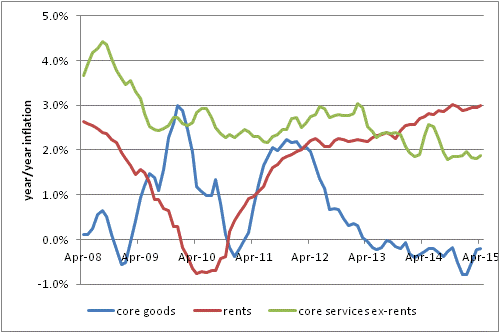Thoughts (And Tweets) Post-CPI
Here is a summary of my post-CPI tweets. You can (and should!) follow me @inflation_guy or sign up for email updates to my occasional articles here. Investors with interests in this area be sure to stop by Enduring Investments.
- CPI Day! Exciting. The y/y for core will “drop off” +0.20% m/m from last yr, so to get core to 1.9% y/y takes +0.29 m/m this yr.
- Consensus looks for a downtick in core to 1.7% y/y (rounding down) instead of the rounded-up 1.8% (actually 1.754%) last mo.
- oohoooooo! Core +0.3% m/m. y/y stays at 1.8%. Checking rounding.
- +0.256% m/m on core, so the 0.3% is mostly shock value. But y/y goes to 1.81%, no round-assist needed.
- Headline was in line with expectations, -0.2% y/y. Big sigh of relief from dealers holding TIPS inventory left from the auction.
- Core ex-shelter was +0.24%, biggest rise since Jan 2013. That’s important.
- This really helps my speaking engagement next mo – a debate between pro & con inflation positions at Global Fixed Income Institute. :-)
- More analysis coming. But Excel really hates it when you focus on another program while a big sheet is calculating…
- It’s still core services doing all the heavy lifting. Core goods was -0.2% y/y (unch) while core services rose to 2.5% y/y.
- Core services has been 2.4%-2.5% since August.
- Owners’ Equivalent Rent rose to 2.77% y/y, highest since…well, a long time.
- Thanks Excel for giving me my data back. As I said, OER was 2.77%, up from 2.69%. Primary rents frll to 3.47% from 3.53%.
- Housing as a whole went to 2.20% y/y from 1.93%, which is huge. Some of that was household energy but ex-energy shelter was 2.67 vs 2.56
- Or housing ex-shelter, ex-energy was 1.14% from 0.67%. Seems I am drilling a bit deep but getting housing right is very important.
- Medical Care +2.91% from 2.46%. Big jump, but mostly repaying the inexplicable dip from Q1. Lot of this is new O’care seasonality.
- Median is a bit of a wildcard this month. Looks like median category will be OER (South Urban), so it will depend on seasonal adj.
- But best guess for median has been 0.2% for a while. Underlying inflation is and has been 2.0%-2.4% since 2011.
- And reminder: it’s median that matters. Core will continue to converge upwards to it, (and I think median will go higher.)
- None of this changes the Fed. They’re not going to hike rates for a long while. Growth is too weak and that’s all they care about.
- For all the noise about the dual mandate, the Fed acts as if it only has one mandate: employment (which they can’t do anything about).
- The next few monthly core figures to drop off are 0.23%, 0.14%, 0.10%, and 0.05%.
- So, if we keep printing 0.22% on core, on the day of the Sep FOMC meeting core CPI will be 2.2% y/y, putting core PCE basically at tgt.
- I think this is why FOMC doves have been musing about “symmetrical misses” and letting infl scoot a little higher.
- US #Inflation mkt pricing: 2015 1.1%;2016 1.8%;then 1.8%, 2.0%, 2.0%, 2.1%, 2.2%, 2.3%, 2.4%, 2.5%, & 2025:2.4%.
- For the record, that is the highest m/m print in core CPI since January 2008. It hasn’t printed a pure 0.3% or above since 2006.
There is no doubt that this is a stronger inflation print than the market expected. Although the 0.3% print was due to rounding (the first such print, though, since January 2013), the month/month core increase hasn’t been above 0.26% since January 2008 and it has been nearly a decade since 0.3% prints weren’t an oddity (see chart, source Bloomberg).

You can think of the CPI as being four roughly-equal pieces: Core goods, Core services ex-rents, Rents, and Food & Energy. Obviously, the first three represent Core CPI. The breakdown (source: BLS and Enduring Investments calculations) is shown below.

Note that in the tweet-stream, I referred to core services being 2.4%-2.5% since August. With the chart above, you can see that this was because both pieces were pretty flat, but that the tame performance overall of core services was because services outside of rents was declining while rents were rising. But core services ex-rents appear to have flattened out, while housing indicators suggest higher rents are still ahead (Owners’ Equivalent Rent, the bigger piece, went to 2.77%, the highest since January 2008). Core goods, too, look to have flattened out and have probably bottomed.
So the basic story is getting simpler. Housing inflation continues apace, and the moderating effects on consumers’ pocketbooks (one-time medical care effects, e.g., which are now being erased with big premium hikes) are ebbing. This merely puts Core on a course to re-converge with Median. If core inflation were to stop when it got to median, the Fed would be very happy. The chart below (Source: Bloomberg) supports the statement I made above, that median inflation has been between 2% and 2.4% since 2011. Incidentally, the chart is through March, but Median CPI was just released as I type this, at 2.2% y/y again.

But that gentle convergence at the Fed target won’t happen. Unless the Federal Reserve acts rapidly and decisively, not to raise rates but to remove excess reserves from the banking system (and indeed, to keep rates and thereby velocity low while doing so, a mean trick indeed), inflation has but one way to go. Up. And there appears little risk that the Fed will act decisively in a hawkish fashion.
Disclaimer: None.



